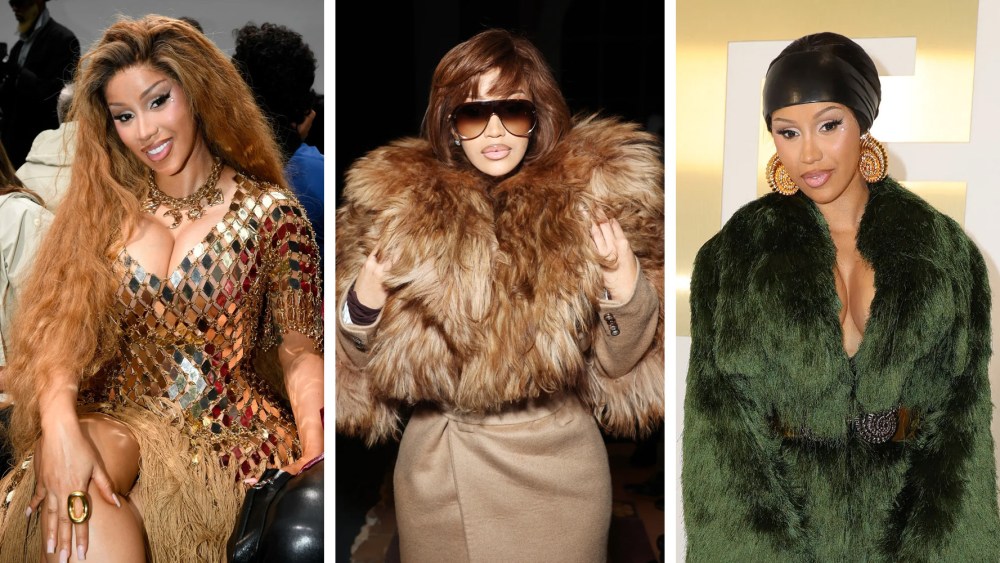It’s been a bumpy start to the year for luxury watch brands and retailers, which are flying through a storm caused chiefly by factors outside their control.
Aspirational shoppers and Chinese consumers are increasingly wary of spending due to cost-of-living crises and higher interest rates, while the Swiss franc has been rising to record highs against the euro and U.S. dollar, driving up production costs and eroding brands’ top and bottom lines.
Against that uneven backdrop, organizers at Watches and Wonders, which takes place from Tuesday to Saturday in Geneva, are putting on a brave face and helping to position brands large and small for success in the longer term.
“Whether the global context is good, or a bit more difficult, we need to talk about watchmaking, we need to be together and to see the future of watchmaking,” said Matthieu Humair, chief executive officer of the Watches and Wonders Foundation, which operates the annual fair.
“Our role is to promote watchmaking around the world and to talk to this young generation, spark new passion, new vocations,” he added.

The strategy to attract new blood appears to be working.
Humair said the average age of people buying tickets for the public days is 35, while 25 percent of tickets were purchased by a cohort of people under 25 years old.
With 54 exhibitors, including eight newcomers, Humair is also expecting to soundly beat last year’s numbers. In 2023 there was a record 43,000 visitors, including 12,000 tickets for the public days, which sold out before the weekend started.
Last year, Watches and Wonders saw 125 nationalities represented; 5,400 retailers; 35,000 overnight stays, and 1,400 members of the press.
While enthusiasm — and expectations — might be flying high ahead of the upcoming fair, the year is still set to be a subdued one for watch sales.
“Retailers will be probably be more cautious with their orders but overall I expect a positive mood in a transitional year,” said Oliver R. Müller, an industry consultant and analyst. “The watch industry is being impacted just as the other luxury segments, especially in the Chinese market where [business] has not returned to pre-COVID[-19] levels.”
In an interview, he added that the pace of growth was already “significantly reduced” in the second half of 2023, and the industry still achieved a record year of exports. He believes 2024 will be “a year of consolidation, slightly below 2023,” with an expected 5 percent decline in export value.
“That would bring the sales back on the level of 2022, which was the previous record year,” he said.
In terms of product, Müller said Watches and Wonders will likely be showcasing “safer” styles, such as variations on existing products, rather than novelties.
Fair-goers should expect to see “a lot of color variations which has been the lead trend for the last few years, first with blue dials, then purple and now green. And I’m also seeing a general trend for more titanium cases and bracelets — they’re lighter and more comfortable to wear. In general brands are becoming more open to new materials,” Müller said.
He also addressed the challenges in the Chinese market, which he described as a “vector of growth” over the past two decades until the pandemic arrived.
“China is becoming more mature and I don’t expect the market to continue at the pace of growth it had the last decade before COVID. The recent economic turmoil linked to the real estate crisis is impacting the middle class and and, by correlation, the middle-priced and entry-level brands.
“The Chinese are traveling less in Europe and are buying more in China, which has been negatively impacting the sales of the Swiss watch brands because their cost base is in Swiss francs and the sales are done in renminbi,” he said.

The Swatch x Tate Gallery Collection. Watches priced below 200 Swiss francs haven’t been impacted by the slowdown in demand. Courtesy of Swatch
Brands and retailers alike have been suffering from the absence of the Chinese customer, as well as a general slowdown in demand.
Watches of Switzerland, the U.K.’s largest luxury watch retailer, was the first to sound the alarm this year when it issued a sales and profit warning in mid-January. The announcement sent the retailer’s share price down 37 percent on the day, and the stock continues to trade well below last year’s levels.
The company’s CEO Brian Duffy said the holiday period was “particularly volatile this year for the luxury sector, with consumers allocating spend to other categories such as fashion, beauty, hospitality and travel.”
He said the company was “disappointed” with the trend, but encouraged by its market share gains in both the U.S. and U.K. in the third quarter of fiscal 2024.
The retailer said sales in the quarter had started on a high note, but turned volatile as macroeconomic conditions impacted luxury spending.
The company, which has more than 200 showrooms across the U.K., U.S. and Europe and nearly 100 dedicated monobrand boutiques in partnership with brands including Rolex, is expecting those adverse conditions to persist through the final quarter ending April 30.
Watches of Switzerland is not alone in feeling the pain.
Swiss watch exports faltered in February, after two years of steady growth and a record 2023.
Exports contracted in value, slipping 3.8 percent year-on-year to just above 2 billion Swiss francs. By volume, they were down 5.2 percent, according to the Federation of the Swiss Watch Industry.
The February numbers marked the “first significant fall after two years of steady growth,” the federation said, attributing the drop partly to a steep decline in Greater China.
Exports to China and Hong Kong, which rank second and third in market size, fell 25.4 percent and 19 percent, respectively.
Earlier this year, the Chinese government unveiled a modest GDP growth target for 2024, which is expected to lead to experience-based consumption rather than purchases, amid weak consumer confidence and asset deprecation.

While other top markets including the U.S., France, Japan and the United Arab Emirates remained on a positive course in the mid- to high-single digits, the Swiss federation noted that this was not enough to compensate for China’s slump.
All price ranges were affected by the month’s lackluster performance, with the biggest impact seen on the 500 Swiss francs to 3,000 Swiss francs category, which slumped over 12 percent in unit terms and 14 percent in value.
Accounting for 80 percent of export turnover, watches priced above 3,000 Swiss francs at export ended February with a moderate 1.8 percent contraction in value and a 6.1 percent volume decrease.
In January, the Federation of the Swiss Watch Industry said it expected lower consumer confidence and the strength of the Swiss franc to have a continuing impact, amounting to a calmer 2024 for exports and employment in the sector.
The analysts at Bernstein added to the chorus, saying it expects demand for luxury watches “to continue normalizing after an impressive performance” over the past two to three years.
The bank pointed out the decrease was “particularly significant” in the 500 to 3,000 francs price range, while watches below 200 francs did not see a decline. Sales of watches made from precious metals remained “relatively stable” in February.
Luxury groups with watch portfolios have clearly been feeling the pain of the powerful Swiss franc.
In the fiscal third quarter, sales at Richemont’s specialist watch division, which includes brands A. Lange & Söhne, IWC, Jaeger-LeCoultre and Vacheron Constantin, rose 3 percent to 939 million euros at constant exchange rates.

At actual exchange rates, however, sales in the division were down 1 percent in the Christmas holiday period, impacted by the strong Swiss franc.
Swatch Group, owner of watch brands including Omega and Breguet as well as the core Swatch label, has also been suffering from the Swiss franc, and the slowdown in luxury demand.
Full-year profits missed consensus expectations in fiscal 2023 as revenue growth slowed.
Although revenue was broadly in line with market expectations, EBIT, or earnings before interest and taxes, fell 10 to 11 percent below analysts’ targets for the full year.
At the time, Bernstein’s Luca Solca said that Swatch Group seems to be a victim of two factors: “consumer demand moderation, which is hitting tier-two brands the most, and the continuing strength of the Swiss franc.”
He pointed out that organic revenue growth in Swatch’s first half was 18 percent, compared with 6.4 percent in the last six months of the year.
Barclays, meanwhile, calculated that second-half sales were down 4 percent versus consensus, and that Swatch Group’s core watches and jewelry division sales missed consensus by 2 percent.
Barclays’ Carole Madjo added that in the second half, “the big miss came from the EBIT line, which was 23 percent below expectations.” The group, she added, faced “significant” foreign exchange headwinds, “and we expect this to be one of the main drivers behind the sharp decline in profit.”
Following those results, Barclays maintained its “underweight” rating on the stock, meaning the bank expects shares to deliver a below-average return compared to the benchmark.

Madjo said the bank fears that Swatch could underperform the market this year, “considering its exposure to more aspirational consumers. We also fear that Swatch could continue to suffer from negative investor sentiment as the management reminded during its recent conference call that it shared different objectives than the financial markets, and paid limited attention to share price moves.”
Indeed, financial analysts and investors alike find Swatch founder-owner Nick Hayek’s unconventional management style frustrating, and Bernstein’s Solca has even made a case for the company’s delisting in a report published earlier this year.

Bernstein described Swatch as a reluctant stock market player with a disdain for investors, noting that a change of ownership would transform the company’s prospects. If things remain as they are, “one could see the Swatch Group share price go nowhere, especially if Chinese middle class demand continued to be lackluster,” the report said.
The storm swirling around the industry doesn’t look to be letting up any time soon. HSBC has downgraded its ratings on most of the leading watch brands in the listed space, and said it was “hard to remain positive,” specifically on Watches of Switzerland, given its cautious stance on the overall luxury watch business.
Still, the organizers of the Watches and Wonders fair remain optimistic for the long run. While 2024 is set to be a subdued year in terms of demand, interest rate downgrades and a rebound in Chinese consumer confidence could spur a change in weather — and result in brighter times ahead.



